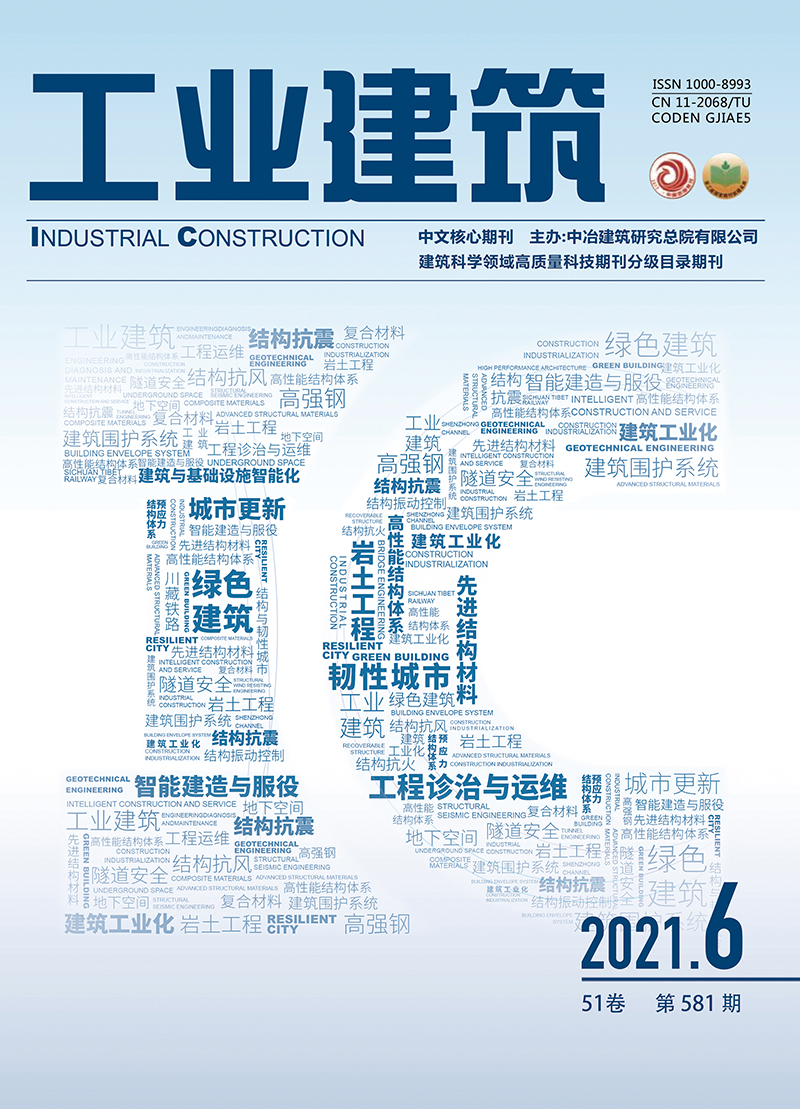| [1] |
赵志方, 赵国藩, 刘健, 等.新老混凝土黏结抗拉性能的试验研究[J]. 建筑结构学报, 2001, 22(2):51-56.
|
| [2] |
肖成志, 田稳苓, 刘波,等.设置界面构造锚筋的新老混凝土黏结性能试验研究[J]. 建筑结构学报, 2011, 32(1):75-81.
|
| [3] |
JULIO E N B S, DIAS-DA-COSTA D, BRANCO F A B, et al. Accuracy of Design Code Expressions for Estimating Longitudinal Shear Strength of Strengthening Concrete Overlays[J]. Engineering Structures, 2010, 32(8):2387-2393.
|
| [4] |
HARRIES K A, ZENO G, SHAHROOZ B. Toward an Improved Understanding of Shear-Friction Behavior[J]. ACI Structural Journal, 2012, 109(6):835-844.
|
| [5] |
ANDERSON A R. Composite Designs in Precast and Cast-in-Place Concrete[J]. Progressive Architecture, 1960, 41(9):172-179.
|
| [6] |
HOFBECK J A, IBRAHIM I O, MATTOCK A H. Shear Transfer in Reinforced Concrete[J]. ACI Journal, 1969, 66(2):119-128.
|
| [7] |
ZIA P. Torsional Strength of Prestressed Concrete Members[J]. ACI Journal, 1961, 57(10):1337-1360.
|
| [8] |
KAHN L F, MITCHELL A D. Shear Friction Tests with High-Strength Concrete[J]. ACI Structure Journal, 2002, 99(1):98-103.
|
| [9] |
郑建岚, 陈锋. 自密实混凝土与老混凝土黏结剪切强度的塑性极限分析[J]. 工程力学, 2008, 25(8):164-168.
|
| [10] |
王振领. 新老混凝土黏结理论与试验及在桥梁加固工程中的应用研究[D]. 成都:西南交通大学, 2007.
|
| [11] |
SANTOS P M D, JULIO E N B S. A State-of-the-Art Review on Shear-Friction[J]. Engineering Structures, 2012, 45(12):435-448.
|
| [12] |
ROBERT A B, RAMON L C, JAMES O J. Shear Transfer Across New and Existing Concrete Interface[J]. ACI Structural Journal, 1989, 86(4):383-393.
|
| [13] |
BIRKELAND P W, BIRKELAND H W. Connections in Precast Concrete Construction[J]. ACI Journal Proceedings, 1966, 63(3):345-368.
|
| [14] |
WALRAVEN J, FRÉNAY J, PRUIJSSERS A. Influence of Concrete Strength and Load History on the Shear Friction Capacity of Concrete Members[J]. PCI Journal, 1987, 32(1):66-84.
|
| [15] |
LOOV R E, PATNAIK A K. Horizontal Shear Strength of Composite Concrete Beams with a Rough Interface[J]. PCI Journal, 1994, 39(1):48-69.
|
| [16] |
RANDL N. Investigations on Transfer of Forces Between Old and New Concrete at Different Joint Roughness[D]. Innsbruck:University of Innsbruck, 1997.
|
| [17] |
叶果. 新老混凝土界面抗剪性能研究[D]. 重庆:重庆大学, 2011.
|
| [18] |
JULIO E N B S, BRANCO F A, SILVA V D. Concrete-to-Concrete Bond Strength Influence of the Roughness of the Substrate Surface[J]. Construction and Building Materials, 2004, 18(9):675-681.
|
| [19] |
张雷顺, 闫国新, 张晓磊, 等. 沟槽式新老混凝土黏结面抗剪强度试验研究[J]. 郑州大学学报(工学版), 2006, 27(2):24-28.
|
| [20] |
常鹏飞. 新旧混凝土界面的连接方法及动力性能研究[D]. 西安:西安科技大学, 2012.
|
| [21] |
邢强. 新旧混凝土界面的连接方法及受力性能研究[D].西安:西安科技大学, 2012.
|
| [22] |
中华人民共和国城乡和住房建设部. 混凝土结构设计规范:GB 50010-2010[S]. 北京:中国建筑工业出版社, 2015.
|
| [23] |
American Concrete Institute Committee. Building Code Requirements for Structural Concrete and Commentary on Building Code Requirements for Structural Concrete:ACI 318-14[S]. Farmington Hills:American Concrete Institute, 2014.
|
| [24] |
Canadian Standards Association. Design of Concrete Structures:CSA A23.3-14[S]. Toronto:CSA 2014.
|
| [25] |
European Committee for Standardization. Design of Concrete Structures:Eurocode 2[S]. London:CEN, 2008.
|
| [26] |
International Federation for Structural Concrete. fib Model Code 2010, Model Code for Concrete Structures[S]. Lausanne:FIB, 2010.
|
| [27] |
AASHTO LRFD 2014, AASHTO LRFD Bridge Design Specifications[S]. Washington:American Association of State Highway and Transportation Officials, 2014.
|
| [28] |
潘传银, 石雪飞, 周可攀. 新、老混凝土黏结抗剪强度试验[J]. 交通科学与工程, 2014, 30(2):6-12.
|
| [29] |
黄璐. 植筋法新旧混凝土界面剪切强度的实用计算公式[C]//第25届全国结构工程学术会议论文集(第Ⅲ册). 包头:2016.
|
| [30] |
刘传奇. 新旧混凝土界面黏贴机理试验研究[D]. 西安:长安大学, 2014.
|
| [31] |
XIAO J Z, SUN C H, LANGE D A. Effect of Joint Interface Conditions on Shear Transfer Behavior of Recycled Aggregate Concrete[J]. Construction and Building Materials, 2016, 105(1):343-355.
|
| [32] |
王二花. 植筋法新老混凝土黏结面剪切性能试验研究[D]. 郑州:郑州大学, 2006.
|
| [33] |
胡铁明, 黄承逵, 陈小锋. 构造钢筋影响下新老混凝土结合面抗剪试验研究[J]. 混凝土, 2009, 233(3):26-28.
|
| [34] |
江志伟. 沟槽和植筋新旧混凝土界面抗剪性能试验研究[D]. 广州:广东工业大学, 2014.
|
| [35] |
HE Y, ZHANG X, HOOTON R D, et al. Effects of Interface Roughness and Interface Adhesion on New-to-Old Concrete Bonding[J]. Construction and Building Materials, 2017, 151(5):582-590.
|
| [36] |
SANTOS P M D, JULIO E N B S. A State-of-the-Art Review on Roughness Quantification Methods for Concrete Surfaces[J]. Construction and Building Materials, 2013, 38(1):912-923.
|
| [37] |
宋国华, 霍达, 王东炜, 等. 装配式大板结构竖向齿槽接缝受剪承载力设计[J]. 土木工程学报, 2003, 36(11):61-64.
|
| [38] |
张锡治, 马健, 韩鹏, 等. 装配式剪力墙齿槽式连接受剪性能研[J]. 建筑结构学报, 2017, 38(11):93-100.
|
| [39] |
DULACSKA H. Dowel Action of Reinforcement Crossing Cracks in Concrete[J]. ACI Journal, 1972, 69(12):754-757.
|
| [40] |
RANDL N. Design Recommendations for Interface Shear Transfer in Fib Model Code 2010[J]. Structural Concrete, 2013, 14(3):230-241.
|
| [41] |
MANSUR M A, VINAYAGAM T, TAN K H. Shear Transfer Across a Crack in Reinforced High-Strength Concrete[J]. ASCE Journal Materials Civil Engineering, 2008, 20(4):294-302.
|
| [42] |
方鑫. 沟槽植筋新旧混凝土(C30)结合面抗剪性能试验研究[D]. 广州:广东工业大学, 2016.
|


 Login
Login Register
Register E-alert
E-alert







 DownLoad:
DownLoad: